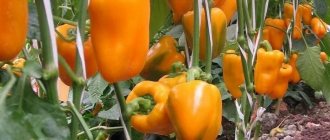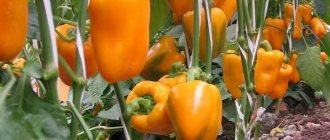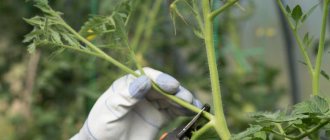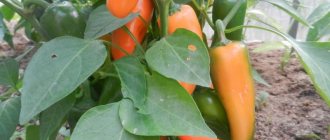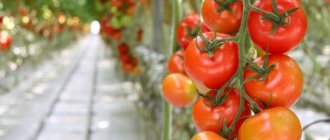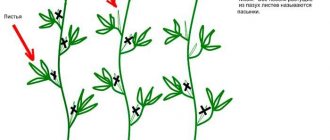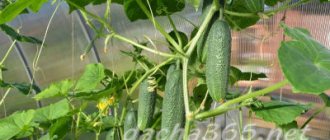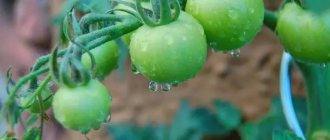To get a bountiful harvest of tomatoes, you need to adjust the shape of the bush. For this purpose, special techniques are used - pinching and pinching. This procedure is especially important for tall varieties and hybrids, which are most often grown indoors, as they allow the area to be used with maximum efficiency.
Read the instructions for forming tomatoes in a greenhouse and the video to successfully perform similar operations in practice.
Why is it necessary to form tomatoes in a greenhouse?
It’s worth starting with the right choice of varieties. Hybrids and indeterminate varieties are best suited for the greenhouse. They will give you a harvest until frost.
To get a rich harvest of tomatoes, the power of the plant must be directed into the development of fruits
And it would be much easier if the tomato bushes grew exclusively upward. But no. Tomatoes have a distinctive feature: in addition to the main trunk, they also like to produce side shoots, the so-called stepsons. They grow in the axils of the leaves, most often with one or two stepsons in each axil. But if you feed your tomatoes like the grandmother of your beloved grandson, then stepsons will appear even on the leaves. And it would seem that there is something wrong with this: big bushes mean a big harvest. But it was not there.
The least of the inconveniences is that by mid-summer you will not even be able to enter the greenhouse. The tomato forest will grow so wide that passage will be very, very difficult. In addition, all the plant’s strength will go into this riot of greenery, and there simply won’t be enough nutrition and short summer for the development and ripening of fruits.
Stepchildren on tomato bushes
And the most unpleasant thing is that in such thickets, diseases feel like at a resort. In poorly ventilated thickets they have complete freedom. Considering all of the above, we conclude: in order to get the maximum yield in a limited area and at the same time avoid contamination of plants and soil, tomato bushes need to be formed.
Why do you need pinching and finishing?
The formation of a tomato bush in a greenhouse involves pinching (see Pinching tomatoes in a greenhouse, why is this necessary?) - removing excess shoots that form in the axils of each leaf. And also in timely pinching the top of the plant. This agrotechnical measure does not allow tomatoes to grow much, forming too many fruiting stems. This is necessary for several reasons:
- Tomatoes, if their growth is not controlled, can grow like a jungle: the stem grows in height throughout the growing season, and stepsons form in the axil of each leaf. Each stepson forms a new stem with flowers and ovaries and its own secondary stepsons. That is, the growth occurs in geometric progression.
If you allow all this to develop, all the plant’s energy will be spent on the formation of green mass and new ovaries, and not on the growth and ripening of fruits.
Note. Low-growing varieties of tomatoes do not require pinching or pruning with your own hands, while tall varieties are prone to rapid growth. But they are the ones recommended for growing in greenhouses for more efficient use of the area of protected soil.
- The abundance of foliage leads to shading of the fruits and poor ripening. But the most unpleasant thing is the development of a variety of fungal diseases. Actively developing due to the fact that thickened plantings are very poorly ventilated, moisture accumulates on the leaves and stems, which does not have time to evaporate.
Unformed bush - an abundance of greenery and small fruits, photo
From the above it is clear that the formation of tomato bushes in a greenhouse helps to solve two important problems: to obtain the highest possible yield from a limited area and to prevent the development of diseases and contamination of the soil. As a bonus to the work done, you will also receive ease of caring for plants. It is much easier to water and fertilize (see: Fertilizing tomatoes in a greenhouse: some practical tips), to collect ripe fruits when the garden bed is in order and not lush.
How to shape
Gardeners recommend different methods for forming a bush. But they all agree on one thing - no more than three stems and no more than eight brushes.
Instructions for planting tomatoes.
- The first pinching is carried out 15–18 days after planting the seedlings in the greenhouse. Subsequently, repeat every 10–14 days.
- The stem on which the first flower cluster formed is considered the main one.
- All shoots that form between the main stem and leaves are stepsons. When they reach 5–6 cm they must be removed.
Stepping up a bush
Advice. It is recommended to remove the stepsons by breaking them off. It is best to do this in the morning.
The stepsons should not be removed at the root, but should be left 2-3 cm. This will help avoid the re-formation of the stepson in this place.
When forming a single-stem bush, it is necessary to remove absolutely all shoots. When forming a bush into two stems, the shoot located below the first brush and closest to it is left. The shoots on the second stem must be removed in the same way as on the main one.
Scheme of tomato bush formation
Each stem should retain no more than four tassels.
Advice. To get an early harvest, you need to pinched several bushes so that no more than three remain, remove the rest and pinch the tops. Then the plant’s forces will be directed to the ripening of the fruits, and not to the growth of the bush.
Tomato bushes must be tied with pegs so that the stems do not break from the load of fruit.
How to ensure good lighting for tomatoes?
Tomatoes are very light-loving plants. I solved the problem for myself as follows - the intervals between plants in the garden bed are at least 50 cm, and in the case of cherry tomatoes - 80 cm. The passages between the beds are more than a meter - I made passages with a shovel handle. My neighbor, when she saw such “wastefulness”, almost fainted.
Wastefulness? Maybe yes. But for me there are only advantages from these giant passages. Firstly, it’s just convenient, you can easily approach any plant, and sometimes even drive up with a wheelbarrow. And such wide passages can simply be mowed with a trimmer. And secondly, and this is probably the most important thing - when tomatoes are planted this way, they literally bathe in the sun all day long.
Pinching the tops
When the required number of clusters with flowers has grown on each stem, it is necessary to cut off the top of the bush. This stage of bush formation is necessary in order to stop the growth of the bush upward and direct all the nutrients directly to the fruits that have already formed. New ovaries will not have time to ripen anyway, so there is no point in wasting energy on them.
Pinching the top of the bush
Each tomato stem is cut off, leaving two leaves on top of the bunches.
Basic rules for forming tomatoes
Once in the comfortable conditions of the greenhouse, tomato seedlings continue to develop the root system and actively grow side shoots. The bush is trying to increase the above-ground part to carry out the process of photosynthesis. In order not to end up with a huge tomato tree in a greenhouse with small and, as a rule, tasteless fruits, competent and, most importantly, timely pruning of leaves and shoots is necessary.
Rules for stepsoning and rationing
The side shoots formed in the leaf axils are called stepsons, since they are formed on the main trunk of the plant. If they are allowed to continue growing, the bush will have many trunks.
The root system cannot cope with such a volume of above-ground parts, and this will negatively affect fruit formation. The plant will have to choose where to direct its energy - to flowering or to feeding foliage. It is easier and more profitable for him to feed the leaves, so there will be few flowers and ovaries.
Cut off the stepsons almost completely, with a stump height of no more than 1 cm. But try not to damage the main stem. The wound left after unsuccessful pinching is an entry point for infection.
Tomatoes in a greenhouse are formed into 1, 2 or 3 stems:
- It is customary to form indeterminate varieties of tomatoes into 1 stem. But I often leave a shoot above the first flower cluster. The result is a two-stem plant, and it is capable of producing more fruits. I cut off the remaining stepsons.
I form determinate mid-late varieties into 3 stems: 2 lower stepsons are left. After the first flower cluster has formed on them, I shorten the remaining stepsons, leaving 1 leaf each.- I form mid-early varieties by transferring the growth point to a side shoot. I leave the lower shoot, and when the second shoot appears, I leave 2–3 fruit clusters on it. I cut off the tops after them, leaving 1 leaf above the ovaries. This helps avoid topping the main stem and allows you to get a few more inflorescences.
Additional shoots can be formed above the first inflorescence. Stepchildren cannot be left on the main and additional stems. Stepchildren that are missed or re-formed in the same leaf axils will inhibit fruit formation, robbing the bush of nutrients.
Determinate varieties bear fruit in a greenhouse for a long time, at least 5 months. Therefore, there is another formation scheme. You need to leave a spare sprout at the top under the second inflorescence. When the stem stops growing, the stepson will continue to grow, and the brushes will go down.
This scheme will increase the growth of the bush. When five clusters form on the stepson, remove its top two nodes to allow the fruit to ripen. Remember about the backup stepson: he can increase the growth of the tomato bush.
Stepchildren form again if you cut off the regrown shoot to the very base. To prevent this from happening, leave a stump height of 3 cm.
Features of the formation of superdeterminate varieties
Superdeterminate tomatoes are low-growing varieties that form no more than 3 inflorescences on each shoot.
You can form them into 2 or 3 stems, depending on what you want to get:
- 3 stems will produce more fruits;
- on 2 stems - there will be fewer fruits, but they will turn out larger.
Pinching the tops
The procedure of pinching the tops is necessary for indeterminate types of tomatoes. It helps limit the upward growth of bushes. This procedure has the following goals:
Does not allow bushes to grow to incredible sizes and rest their crowns on the ceiling of the greenhouse. Contact of the top of a tomato with the ceiling leads to overheating of the plant and burn of the leaves.
Limits the number of flower clusters, which helps the plant direct its forces to the formation of ovaries. If the crown is not pinched, the bush will continue to produce new buds. But all the resulting flowers will not have time to set and bear fruit in a short summer. Tomatoes that have already set will grow slowly and will not have time to ripen before the onset of cold weather.
Expert opinion
Istomina Karina Bogdanovna
Agronomist with knowledge and skills in growing vegetables
I carry out the pinching procedure in the morning, in sunny and warm weather. This allows the damaged areas to heal in the evening. After the bush produces the required number of flower brushes, I leave 2 leaves above the top one and cut off the crown. After this procedure, the plant stops growing and begins to form ovaries.
The number of brushes depends on the number of stems:
- 7 inflorescences when formed into 1 stem;
- 12 when forming into 2 stems.
Tall tomatoes, formed into 2 stems, require more nutrients for growth and fruiting. Therefore, give them 1-2 additional feedings during the growing season.
Leaf trimming
The need to trim leaves when growing tomatoes in a greenhouse has been causing heated debate among gardeners for a long time. Some of them claim that it is necessary to completely remove all leaves. This, in their opinion, prevents both fungal infections and wasted energy of tomato bushes on leaf growth. In addition, this provides greater access to air and lighting for the bush. With this formation, only the top two or three leaves are left.
Removing the lower leaves from a tomato bush
Other gardeners argue that complete pruning of leaves disrupts circulation, thereby destroying nutritional processes, and also limits the photosynthesis of the plant. This part of tomato experts recommends removing only the lower leaves on the plant, as well as yellowed and dried ones.
Advice. You can choose the best method for yourself. Make part of the tomato bed with leaves, and cut the other part and look at the result.
There are many methods for forming a bush. Each gardener does this in his own way. However, everyone has the same goal - to get the maximum yield from a small area. If all agrotechnical measures are carried out correctly, you will create favorable conditions for weight gain and fruit ripening.
Bush formation should be carried out only with sterile instruments
You can watch the video in detail about the formation of tomato bushes in a greenhouse.
Common mistakes of beginner gardeners + video
At first glance, both pinching and pinching tomatoes are not particularly difficult. However, the lack of sufficient experience can lead to certain mistakes that will negatively affect the development of plants and ultimately the harvest. It will be easier to master these operations if you first watch a video of how professionals form tomatoes in a greenhouse and what equipment and materials they use for this.
Video: Forming tomatoes in a greenhouse according to all the rules
It happens that the growth of the top of the main stem stops after the formation of a flower cluster. Therefore, you should not rush to remove the first stepson - it will be able to replace the main stem if it stops growing. Perform pinching only after making sure that the main shoot has continued its development after the appearance of the first cluster.
If you miss time, the lateral processes may develop well and it will be a pity to remove them. But this operation is necessary, even if there is a fear of damaging the bush. It is advisable to monitor the appearance of stepchildren and prevent their excessive growth.
The result of proper bush formation is a high yield of quality tomatoes.
Growing vegetables in a greenhouse is a fascinating process and a profitable activity. For lovers, this is the best way to diversify and enrich your winter diet with vitamins. For entrepreneurs it is a source of stable high income. And in both cases, an important success factor is the correct application of agricultural methods. If you have any questions, you can always contact specialists who will provide qualified information support and help you learn the necessary skills.
Tomato bushes in a greenhouse: photo
Proper watering of tomatoes
Also, as I wrote above, the condition for long-term fruiting is moderate soil moisture and dry air. Pruning and removing leaves is already half the success. All that remains is to carefully water the bush from a hose (preferably with a sprayer at the end) under the root and mulch with something.
I cover the ground with mowed grass, after letting it dry a little in the sun. I water on top of the grass, it dries out quickly, but the ground underneath remains moist. Thus, tomatoes should be watered no more than once every 3-4 days. Below, moreover, there are no leaves, only a bare trunk, which will also dry out quickly. And all the green mass at the top will be dry and water will not touch it.
The tomato must be tied up.
Caring for greenhouse tomatoes
Greenhouse plants require constant care; they are not weeds that will grow on their own. In order for the seedlings to feel comfortable in the greenhouse, it is necessary to constantly attend to it and monitor the development of the seedlings. Such plants simply need your help; this is why seedlings are planted in greenhouses, in order to grow a full-fledged fertile plant from a small seed. When the seedlings grow, it is necessary to form bushes, weed the seedlings and water them.
Pinching is a very important process
Most often, gardeners grow crops in greenhouses such as cucumbers, peppers, and other vegetables. Tomatoes deserve special attention; growing this vegetable differs from caring for all other plants. In order for the harvest to be rich, it is necessary to pluck off the shoots, and in order for the bush to form correctly, pinching must be done.
Remove diseased and yellowed leaves
In addition to the stepsons, only diseased and yellowed leaves are removed from tomatoes, as well as leaves covering the fruits of the lower clusters of the plant when these clusters are fully formed. The remaining leaves should not be cut from tomatoes, since the leaves are needed for the synthesis of organic materials. In addition, the leaves protect the plant from cold mornings - low air temperatures in the morning.
At the end of August - beginning of September, the top of the main shoot is removed . At the same time, all flower clusters are torn off, since the fruits on them will no longer have time to form, but they will not allow the already formed fruits to develop normally. This technique can speed up the development of the remaining fruits on the plant.
Acceleration of bush formation and fruit development
To accelerate the formation and development of fruits, we can recommend another agrotechnical technique, which is called “tearing the roots.”
It consists in the following. The plant is taken by the lower thickened part of the stem and carefully pulled up, as if trying to pull it out of the soil. The purpose of this technique is to tear off the small roots of the plant. After this, the plant is watered and its root system is hilled. Experience shows that after this there is accelerated growth, formation and ripening of fruits. Did you like the material?
Share the link with your friends on a social network: If you
find an error in the text
, please let us know: select it and press:
Ctrl + Enter
!
rassadnik.com
Tomato garter
I also want to note that the tomato must be tied up. This plant has a weak trunk that cannot bear the full weight of leaves and fruits. Without support, the plant will lie on the ground.
And in order for the plant to be well ventilated, healthy and bear fruit for a long time, it is not enough to remove the stepsons and some of the leaves. After all, if we leave it to grow lying on the ground, then we will not see a good and, especially, long-lasting harvest, all for the same reason - late blight, and there will be little sun.
Therefore, I recommend tying up tomatoes. Everyone does it in their own way. Some people drive sticks into the ground, huge sharpened stakes and tie each plant, others tie it to the arches. I think this is not important. It’s more convenient for me to dig in U-shaped trellises made of wooden slats (they are reusable), and I tie each plant to the transverse slats with a synthetic rope.
Some people do it with twine. Whoever likes it. If the plant is formed into one trunk, then I tie it to it, first making a large loop (with a reserve for growth, the trunk will get thicker), and then I twist the rope around the trunk counterclockwise to the very top and loosely tie it to the transverse rail. If anything, I'll pick it up later.
The fact that you need to tighten it counterclockwise is an important point. Since the tomato turns to follow the sun, if the rope is wound in some other way, it will simply fall off it.
If the tomato is determinate and has 2 trunks, then I tie them both up. In the case of cherry trees, I tie them with several ropes on different sides so that the branches do not lie on the ground.
By the way, last year I didn’t have enough slats for all the tomatoes and two cherry bushes were left lying on the ground. It turned out to be such a spontaneous experiment - the harvest from these bushes was much more modest compared to the others, and the fruits began to rot while still on the branch. Therefore, you still need to tie it up.
On a note! The most important thing when growing tomatoes is to remember where they come from - it is a warm, dry region. Hence the necessary care - he needs to be provided with conditions as close as possible to his homeland, namely: good lighting, dry air, ventilation, moderate soil moisture.
Benefit
In order for tomatoes to ripen earlier and produce a good harvest and large fruits, you must pinch them on time. The harvest will depend on the timeliness of this process. A timely procedure guarantees large fruits, their abundance and quality. The axils of the leaves of the seedling form stepsons that need to be torn off, and in a timely manner, so that the flower brush does not lag behind in its development.
New shoots that form on tomatoes should break off before they reach 6 centimeters in size. This is the only way you will not harm the plant, because the wounds on its trunk will heal quickly. Stepchildren should not be left, because they interfere with the full development of the seedling. The process in question should be repeated every few weeks, starting 7-10 days after planting the seedlings in the greenhouse.
Methods
The formation of the bush directly depends on the variety of tomatoes. There are several ways to form the stem of a seedling.
- If the tomatoes are tall, then we form them into one stem. Do not forget that it is necessary to cut off the stepsons throughout the summer period. In addition to the new stems, you should pinch the very top of the seedling. This process is carried out so that the fruit is saturated with moisture and all the vitamins, and not the trunk;
- The formation system is double-stem. In this case, you also need to leave the stepson (preferably one), he will lag a little behind in development, but the method of care under consideration will affect the tomato harvest. Do not forget that this method slows down the ripening of fruits; there is a possibility that the crop may not ripen before the first frost;
- Three-stem system. This method is used for early varieties of tomatoes. Here, as in the previous method, you need to leave the stepsons located under the flower brush of the seedling. There may be several brushes; new stems are left under the flower of the main trunk of the seedling.
Many amateur gardeners have no idea when to start forming bushes; the result is disappointing - the bushes are lush, but the harvest is meager. The main thing is not the appearance of the bush, but how much fruit it produces. Do not lose sight of the fact that the ovaries on tomatoes need to be thinned out.
For pinching, you can arm yourself with pruning shears
If the seedlings are not properly cared for, it may turn out that there will be a lot of brushes on the bush, and the size of the fruits will be very small. Proper cultivation and pinching of seedlings gives a wonderful harvest and brings joy to the gardener. If an amateur gardener has an orderly greenhouse, all procedures are carried out on time, the harvest will be great.
